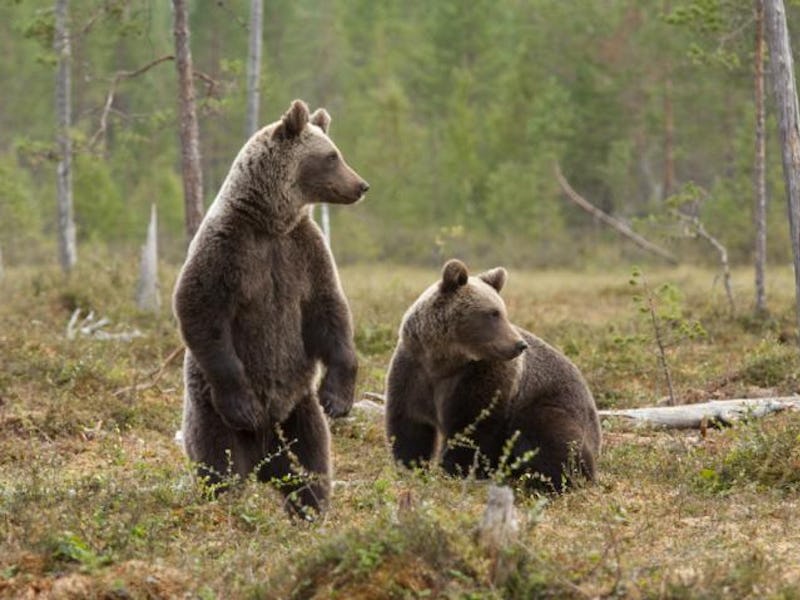Researchers Find a New Use for Wild Bear Saliva That Could Help Sick People
Yes, they actually caught a bear

Antibiotic resistance is a devastating problem that can make it harder to fight, but somewhere out in the wilderness, there’s a wild animal whose saliva may have the answers we seek, according to the authors of a paper published Thursday in Proceedings of the National Academy of Sciences, who embarked on a bear hunt of sorts in search of helpful microbial treasure.
The catch-and-release mission was intended to help identify potential therapies that may lie hidden in the bear’s microbiome, as study co-author and professor of microbial genetics at Rutgers University Konstantin Severinov, Ph.D., tells Inverse. But it was essential for this line of inquiry that the researchers use a wild animal with gut bacteria untainted by the modern world:
“There’s some data showing that animals in the zoo have much more common microbiota than the same animals if you take them in the wild,” Severinov says, but aside from that, wild animals also tend to be pretty hearty individuals. “Wild animals eat whatever and drink god-knows-what. So one hypothesis is that the microbes that inhabit them, in a way, protect them.”
The researchers used Siberian Bear Saliva. The Siberian bear is a widespread symbol of Russia, and notably the Ministry of Education and Science of Russia sponsored this study
Identifying those microbes, and the potentially protective compounds they produce could be a method to developing antibiotic treatments — although Severinov adds that this has yet to be fully tested. But historically, this is akin to how we’ve found our most important infection-fighting tools in the past. In the 1950s, Selman Waksman identified a host of antibiotics in soil microbes including streptomycin, which was the first anti-biotic used to cure tuberculosis. He won a Nobel Prize for this work, which interestingly was done at The Waksman Institute of Biotechnology which is also affiliated with this recent study.
Thousands of Tiny Test Tubes
Using bear saliva to try to solve human problems is interesting in itself, but Severinov points out that his paper also describes a technique that allows researchers to probe any type of microbiome from humans to komoto dragons (they were considering using these lizards instead of the bear) with novel speed and accuracy.
Instead of cultivating different types of microbes in a petri dish, these researchers use thousands of tiny oil droplets to investigate each and every aspect of the bear’s microbiome. In each droplet, they were able to combine a microbe from the bear’s saliva, with different types of infectious bacteria and then compare how well each one reacted to the infectious bacteria.
“Essentially it’s like having thousands of little test tubes where each bacteria grows without influencing the other, and then you can sort them and separate the ones you want from the ones you don’t,” he explains.
An illustration of how the researchers extracted, separated and tested the different microbiota in the bear's saliva
Analysis of these thousands of droplets crowned a winner: one droplet in which all the infectious bacteria had been killed. Severinov explains that this droplet contained a strain of Bacillus Pumilus, with a set of genes that helped it produce amicoumacin, a common antibiotic known to treat staph infections.
Microbial Dark Matter
While amicoumacin is by no means a new discovery, this team did identify something unique about this strain of B. Pumilus. It had another cluster of genes that also made it resistant to the antibiotic is was producing.
This didn’t surprise Severin in particular. “If you consider any microbe that produces noxious stuff, you have to assume that the microbe itself is resistant to that noxious stuff it produces,” he explains. It’s genes coded for an enzyme that made a tiny chemical change in the amicoumacin rendering it incapable of killing its host. In the paper, the authors describe it as a “unique mechanism of Bacillus self- resistance.”
This process is a long way from being adapted to human medicine, says Severin. But it is an illustration that if we keep looking in strange places, we never know what we might find, and how it might be useful down the road.
“There is this overarching idea that we don’t know maybe 99 percent of microbes that are out there, “ Severin says. “These are like dark matter because we can’t cultivate them or because you can’t get to them,” he concludes.